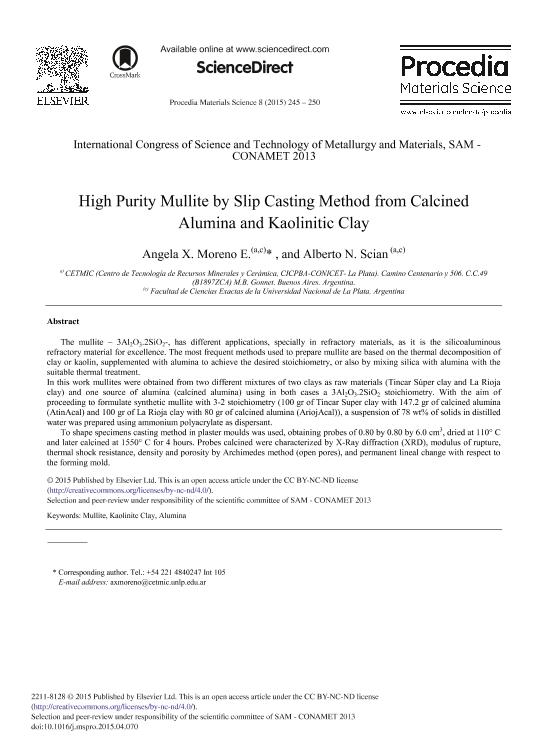Artículo
High Purity Mullite by Slip Casting Method from Calcined Alumina and Kaolinitic Clay
Fecha de publicación:
05/2015
Editorial:
Elsevier
Revista:
Procedia Materials Science
ISSN:
2211-8128
Idioma:
Inglés
Tipo de recurso:
Artículo publicado
Clasificación temática:
Resumen
The mullite – 3Al2O3.2SiO2-, has different applications, specially in refractory materials, as it is the silicoaluminous refractory material for excellence. The most frequent methods used to prepare mullite are based on the thermal decomposition of clay or kaolin, supplemented with alumina to achieve the desired stoichiometry, or also by mixing silica with alumina with the suitable thermal treatment. In this work mullites were obtained from two different mixtures of two clays as raw materials (Tincar Súper clay and La Rioja clay) and one source of alumina (calcined alumina) using in both cases a 3Al2O3.2SiO2 stoichiometry. With the aim of proceeding to formulate synthetic mullite with 3-2 stoichiometry (100 gr of Tincar Super clay with 147.2 gr of calcined alumina (AtinAcal) and 100 gr of La Rioja clay with 80 gr of calcined alumina (AriojAcal)), a suspension of 78 wt% of solids in distilled water was prepared using ammonium polyacrylate as dispersant. To shape specimens casting method in plaster moulds was used, obtaining probes of 0.80 by 0.80 by 6.0 cm3, dried at 110° C and later calcined at 1550° C for 4 hours. Probes calcined were characterized by X-Ray diffraction (XRD), modulus of rupture, thermal shock resistance, density and porosity by Archimedes method (open pores), and permanent lineal change with respect to the forming mold.
Palabras clave:
Mullite,
,
Kaolinitc Clay,
,
Alumina
Archivos asociados
Licencia
Identificadores
Colecciones
Articulos(CETMIC)
Articulos de CENTRO TECNOL.DE REC.MINERALES Y CERAMICA (I)
Articulos de CENTRO TECNOL.DE REC.MINERALES Y CERAMICA (I)
Citación
Moreno Erazo, Angela Ximena; Scian, Alberto Nestor; High Purity Mullite by Slip Casting Method from Calcined Alumina and Kaolinitic Clay; Elsevier; Procedia Materials Science; 8; 5-2015; 245-250
Compartir
Altmétricas




